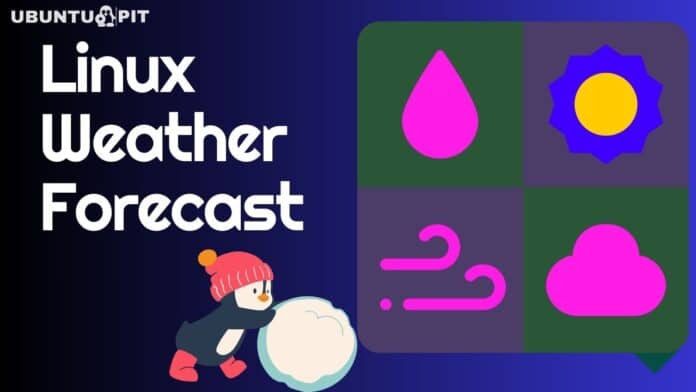Since software development is an evolving sector, Linux serves as a cornerstone of flexibility, providing a robust platform for innovative solutions. Today, we begin a very interesting journey to understand the integration of Linux with Weather APIs, revealing technological nuances and providing developers useful information in terms of sample codes and tools that will allow working on weather data integration to be as painless as possible.
Selecting the Right Weather API
Before delving into integration, it’s crucial to choose the right Weather API for your project. APIs Tomorrow.io, Weatherbit, and Climacell (Now Tomorrow.io) are renowned for their versatility and are highly popular. For example, Tomorrow.io provides hyper-local minute-by-minute forecasts and comes with extensive documentation that makes getting started very easy.
Resource Link: 10 Best Weather Tools for Linux System
Carefully consider your application’s requirements and select an API that aligns with your goals. The following points can help you identify the best Weather API for your needs:
- The accuracy and consistency of a weather API are important aspects of the choice when building applications. The availability of weather data retrieved from an application programming interface is another significant aspect to examine, as well as the reliability of uptime and repeatability.
- Check that the API provides weather data for the appropriate geographical units and consider global coverage if it is important for you to support international users.
- Determine the nature of data on weather conditions provided by the API, namely temperature, onset or base rate of precipitation, wind strength, and humidity. Moreover, try levels of data granularity – hourly, every day, or any other one you might need to ensure your app reaches its full potential.
- Depending on its use, historical data may be of aid regarding specified applications or certain analyses. Go through and ensure that a retrospective weather data API is made available to satisfy your project requirements.
- Evaluate the API and how well it delivers accurate and dependable weather prognoses in both the short and long term. This is most relevant if the application uses forecast data as an input for planning and policy formulation.
Setting Up Your Linux Environment
Before you begin the integration, make sure your Linux environment is equipped with tools that work together seamlessly. For instance, using package managers such as APT for Debian-based systems or YUM for Red Hat-based systems can simplify the installation process and required dependencies.
Let’s take a look at a sample code snippet to set up a basic development environment in Linux:
Install Required Packages
sudo apt-get update
sudo apt-get install -y python3 python3-pip
Install Additional Libraries
pip3 install requests
Integrating Weather Data with Python and Linux
Let’s dive into a practical example of integrating weather data into a Python application on Linux using the Tomorrow.io API. Begin by obtaining an API key from Tomorrow.io. Then, implement the following sample code:
Import Requests
#Replace ‘YOUR_API_KEY’ with your Tomorrow.io API key#
api_key = 'YOUR_API_KEY'
city = 'New York'
url = f'https://api.tomorrow.io/v4/timelines?location={city}&apikey={api_key}'
response = requests.get(url)
data = response.json()
Extract Relevant Weather Information
temperature = data['data']['timelines'][0]['intervals'][0]['values']['temperature']
description = data['data']['timelines'][0]['intervals'][0]['values']['weatherCode']
print(f'Temperature in {city}: {temperature} Celsius')
print(f'Weather Description: {description}')
Advanced Tips: Enhancing Weather Data Integration
a. Caching Mechanism: Use a caching mechanism to prevent the system from undue API calls and improve application performance. Tools such as Redis or Memcache can be quite useful for this purpose.
b. Error Handling: Implement robust mechanisms for coping with situations where the API cannot be accessed or returns unexpected data.
Visualization Tools: Making Weather Data Tangible
To visualize data more interactively, incorporate visualization tools like Matplotlib and Plotly into the program, which can produce exciting, dynamic charts and graphs exemplifying seasonal patterns during different time intervals. This not only brings a better user experience but also allows developers to fully understand the data.
Let’s explore how Plotly can be used to visualize weather information effectively.
a. Temperature Trends Over Time: Create a plot in Plotly with a line chart to show temperature changes in a given period. Such interactive and visual displays can be very educational for users to realize the changing temperature patterns and make their own plans. Here’s a sample code snippet to get you started:
import plotly.express as px
#Assume ‘temperature_data’ is a list of temperature values over time#
fig = px.line(x=list(range(len(temperature_data))), y=temperature_data, labels={'x': 'Time', 'y': 'Temperature'},
title='Temperature Trends Over Time')
fig.show()
Hourly Weather Forecast: Plotly’s bar chart can be a successful part of an algorithm that needs more precise hourly forecasting for applications where the one-day forecasting is not accurate enough.
import plotly.express as px
#Assume ‘hourly_data’ is a dictionary containing hourly weather information#
fig = px.bar(x=list(hourly_data.keys()), y=list(hourly_data.values()), labels={'x': 'Hour', 'y': 'Weather Parameter'},
title='Hourly Weather Forecast')
fig.show()
Geospatial Weather Visualization: Through Plotly’s interactive maps, the weather patterns can easily be exemplified in a geographic location format, which is quite simple to understand. Scattered plots or map visualizations with heat map options can be used to illustrate variations in temperature values, precipitation amounts, and other weather indices.
import plotly.express as px
#Assume ‘geospatial_data’ is a dataframe with location-based weather information#
fig = px.scatter_geo(geospatial_data, lat='Latitude', lon='Longitude', color='Temperature', hover_name='City', size='Population', title='Geospatial Weather Visualization') fig.show()
Being an open-source environment, Linux allows working with weather APIs seamlessly, and as a result, the developers have plenty of options to choose their preferred APIs for their applications.
Thus, an appropriate API, when coupled with a suitable development environment and cutting-edge methods, can be used to fully utilize Linux’s power to develop inventive solutions using the current weather information in real-time.
